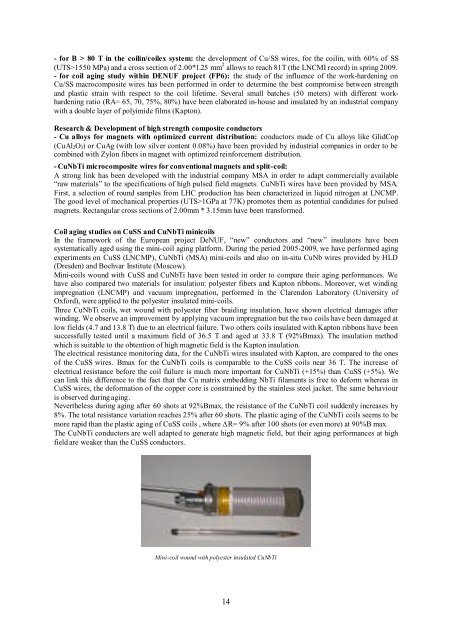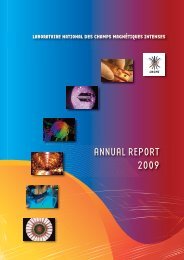Laboratoire National des Champs Magnétiques Pulsés CNRS – INSA
Laboratoire National des Champs Magnétiques Pulsés CNRS – INSA
Laboratoire National des Champs Magnétiques Pulsés CNRS – INSA
You also want an ePaper? Increase the reach of your titles
YUMPU automatically turns print PDFs into web optimized ePapers that Google loves.
- for B > 80 T in the coilin/coilex system: the development of Cu/SS wires, for the coilin, with 60% of SS<br />
(UTS>1550 MPa) and a cross section of 2.00*1.25 mm 2 allows to reach 81T (the LNCMI record) in spring 2009.<br />
- for coil aging study within DENUF project (FP6): the study of the influence of the work-hardening on<br />
Cu/SS macrocomposite wires has been performed in order to determine the best compromise between strength<br />
and plastic strain with respect to the coil lifetime. Several small batches (50 meters) with different workhardening<br />
ratio (RA= 65, 70, 75%, 80%) have been elaborated in-house and insulated by an industrial company<br />
with a double layer of polyimide films (Kapton).<br />
Research & Development of high strength composite conductors<br />
- Cu alloys for magnets with optimized current distribution: conductors made of Cu alloys like GlidCop<br />
(CuAl2O3) or CuAg (with low silver content 0.08%) have been provided by industrial companies in order to be<br />
combined with Zylon fibers in magnet with optimized reinforcement distribution.<br />
- CuNbTi microcomposite wires for conventional magnets and split-coil:<br />
A strong link has been developed with the industrial company MSA in order to adapt commercially available<br />
“raw materials” to the specifications of high pulsed field magnets. CuNbTi wires have been provided by MSA.<br />
First, a selection of round samples from LHC production has been characterized in liquid nitrogen at LNCMP.<br />
The good level of mechanical properties (UTS>1GPa at 77K) promotes them as potential candidates for pulsed<br />
magnets. Rectangular cross sections of 2.00mm * 3.15mm have been transformed.<br />
Coil aging studies on CuSS and CuNbTi minicoils<br />
In the framework of the European project DeNUF, “new” conductors and “new” insulators have been<br />
systematically aged using the mini-coil aging platform. During the period 2005-2009, we have performed aging<br />
experiments on CuSS (LNCMP), CuNbTi (MSA) mini-coils and also on in-situ CuNb wires provided by HLD<br />
(Dresden) and Bochvar Institute (Moscow).<br />
Mini-coils wound with CuSS and CuNbTi have been tested in order to compare their aging performances. We<br />
have also compared two materials for insulation: polyester fibers and Kapton ribbons. Moreover, wet winding<br />
impregnation (LNCMP) and vacuum impregnation, performed in the Clarendon Laboratory (University of<br />
Oxford), were applied to the polyester insulated mini-coils.<br />
Three CuNbTi coils, wet wound with polyester fiber braiding insulation, have shown electrical damages after<br />
winding. We observe an improvement by applying vacuum impregnation but the two coils have been damaged at<br />
low fields (4.7 and 13.8 T) due to an electrical failure. Two others coils insulated with Kapton ribbons have been<br />
successfully tested until a maximum field of 36.5 T and aged at 33.8 T (92%Bmax). The insulation method<br />
which is suitable to the obtention of high magnetic field is the Kapton insulation.<br />
The electrical resistance monitoring data, for the CuNbTi wires insulated with Kapton, are compared to the ones<br />
of the CuSS wires. Bmax for the CuNbTi coils is comparable to the CuSS coils near 36 T. The increase of<br />
electrical resistance before the coil failure is much more important for CuNbTi (+15%) than CuSS (+5%). We<br />
can link this difference to the fact that the Cu matrix embedding NbTi filaments is free to deform whereas in<br />
CuSS wires, the deformation of the copper core is constrained by the stainless steel jacket. The same behaviour<br />
is observed during aging.<br />
Nevertheless during aging after 60 shots at 92%Bmax, the resistance of the CuNbTi coil suddenly increases by<br />
8%. The total resistance variation reaches 25% after 60 shots. The plastic aging of the CuNbTi coils seems to be<br />
more rapid than the plastic aging of CuSS coils , where �R= 9% after 100 shots (or even more) at 90%B max.<br />
The CuNbTi conductors are well adapted to generate high magnetic field, but their aging performances at high<br />
field are weaker than the CuSS conductors.<br />
Mini-coil wound with polyester insulated CuNbTi<br />
14







